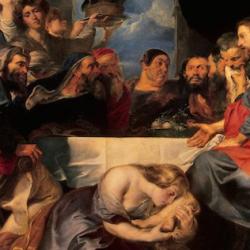Why do the disciples put their garments down in front of Jesus as he comes into Jerusalem? Why did Jehu’s soldiers do the same for him in 2 Kings 9? A couple of answers are possible:
1) Perhaps there is some sort of parallel between this practice and the scene in Aeschylus’ Agamemnon , where Clytemnestra welcomes Agamemnon home from Troy and tempts him to walk over a fabric. This is taken as a kind of blasphemy, Agamemnon in some sense claiming godhead. I suspect the symbolism here has to do with the fact that Agamemnon is no longer walking on the earth. Though he is not elevated in heaven, he is striding across the earth without touching the earth. Perhaps there’s something similar in the biblical practice ?Ethe king is separated from the ground, walking above it.
2) More likely, in my view, is the notion that the garments represent persons and especially a person’s glory. Clothing manifests and represents persons, and throwing garments down means submitting to become the footstool of the king. Clothing also manifests the glory of a person, and throwing down garments is putting down one’s glory (perhaps putting one’s glory in the dust) in the presence of the greater glory of the king, as the elders in Revelation throw down their crowns before the Lord. Jehu’s troops would be wearing military gear of some sort, and throwing down their robes would be a dramatic sign that they were devoting their energies and achievements to the service of Jehu.
3) There is some importance too in the fact that those who remove their outer robes would be standing “naked” before the king (they would not have their outer garments at least). There is a parallel here with David’s “nakedness” before Yahweh. The disciples of Jesus “play the fool” in the presence of the true king.











